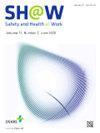A Systematized Overview of Published Reviews on Biological Hazards, Occupational Health, and Safety
IF 3.5
3区 医学
Q1 PUBLIC, ENVIRONMENTAL & OCCUPATIONAL HEALTH
引用次数: 0
Abstract
Introduction
The COVID-19 pandemic turned biological hazards in the working environment into a global concern. This systematized review of published reviews aimed to provide a comprehensive overview of the specific jobs and categories of workers exposed to biological hazards with the related prevention.
Methods
We extracted reviews published in English and French in PubMed, Embase, and Web of Science. Two authors, working independently, subsequently screened the potentially relevant titles and abstracts recovered (step 1) and then examined relevant full texts (step 2). Disagreements were resolved by consensus. We built tables summarizing populations of exposed workers, types of hazards, types of outcomes (types of health issues, means of prevention), and routes of transmission.
Results
Of 1426 studies initially identified, 79 studies by authors from every continent were selected, mostly published after 2010 (n = 63, 79.7%). About half of the reviews dealt with infectious hazards alone (n = 38, 48.1%). The industrial sectors identified involved healthcare alone (n = 16), laboratories (n = 10), agriculture (including the animal, vegetable, and grain sectors, n = 32), waste (n = 10), in addition of 11 studies without specific sectors. The results also highlighted a range of hazards (infectious and non-infectious agents, endotoxins, bioaerosols, organic dust, and emerging agents).
Conclusion
This systematized overview allowed to list the populations of workers exposed to biological hazards and underlined how prevention measures in the healthcare and laboratory sectors were usually well defined and controlled, although this was not the case in the agriculture and waste sectors. Further studies are necessary to quantify these risks and implement prevention measures that can be applied in every country.
关于生物危害、职业健康和安全的已发表评论的系统化概述
2019冠状病毒病大流行使工作环境中的生物危害成为全球关注的问题。本文对已发表的综述进行了系统化的综述,旨在全面概述暴露于生物危害的特定工作和工人类别以及相关的预防措施。方法提取PubMed、Embase和Web of Science上发表的英文和法文综述。两位独立工作的作者随后筛选了可能相关的标题和检索到的摘要(步骤1),然后检查了相关的全文(步骤2)。分歧通过协商一致解决。我们建立了表格,汇总了暴露工人的人群、危害类型、结果类型(健康问题类型、预防手段)和传播途径。在最初确定的1426项研究中,选择了来自各大洲作者的79项研究,其中大部分发表于2010年之后(n = 63,79.7%)。大约一半的综述只涉及感染性危害(n = 38, 48.1%)。确定的工业部门仅涉及医疗保健(n = 16)、实验室(n = 10)、农业(包括动物、蔬菜和粮食部门,n = 32)、废物(n = 10),此外还有11项没有具体部门的研究。结果还强调了一系列危害(感染性和非感染性病原体、内毒素、生物气溶胶、有机粉尘和新兴病原体)。结论:这一系统化的概述列出了暴露于生物危害的工人群体,并强调了卫生保健和实验室部门的预防措施通常是如何得到良好界定和控制的,尽管农业和废物部门并非如此。有必要进行进一步的研究,以量化这些风险并实施可适用于每个国家的预防措施。
本文章由计算机程序翻译,如有差异,请以英文原文为准。
求助全文
约1分钟内获得全文
求助全文
来源期刊

Safety and Health at Work
Social Sciences-Safety Research
CiteScore
6.40
自引率
5.70%
发文量
1080
审稿时长
38 days
期刊介绍:
Safety and Health at Work (SH@W) is an international, peer-reviewed, interdisciplinary journal published quarterly in English beginning in 2010. The journal is aimed at providing grounds for the exchange of ideas and data developed through research experience in the broad field of occupational health and safety. Articles may deal with scientific research to improve workers'' health and safety by eliminating occupational accidents and diseases, pursuing a better working life, and creating a safe and comfortable working environment. The journal focuses primarily on original articles across the whole scope of occupational health and safety, but also welcomes up-to-date review papers and short communications and commentaries on urgent issues and case studies on unique epidemiological survey, methods of accident investigation, and analysis. High priority will be given to articles on occupational epidemiology, medicine, hygiene, toxicology, nursing and health services, work safety, ergonomics, work organization, engineering of safety (mechanical, electrical, chemical, and construction), safety management and policy, and studies related to economic evaluation and its social policy and organizational aspects. Its abbreviated title is Saf Health Work.
 求助内容:
求助内容: 应助结果提醒方式:
应助结果提醒方式:


